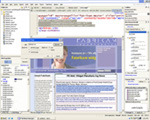Office 2007: FrontPage is out, blogging is in

In a move which reflects the changing face of the Web, with advanced users scaling up to Dreamweaver and blogs becoming the new home page, Microsoft has closed the book on its 10-year-old Web site authoring software.
 |
| [Click to enlarge] A look at Expression Web Designer. |
In its place are two new programs aimed at developers and designers, while Word 2007 now doubles as a blogging client.
Express yourself
Expression Web Designer steps up to the plate as Microsoft's new
program of choice for building Web sites and is expected to ship
before year's end. Unlike FrontPage, it doesn't belong to the
Office family and isn't found in any of the Office 2007 bundles.
The fresh-baked program is part of the new Expressions line,
which also includes Expressions Graphic Designer and Expressions
Interactive Designer. Demo versions of all three programs can be
downloaded here.
Its sibling, SharePoint Designer 2007, is aimed at code-cutters needing to create and customise SharePoint intranet sites and build SharePoint-based applications and document workflows.
Both programs have been built around supporting modern Web standards such as cascading style sheets (CSS), XML and XHTML support plus drag-and-drop ASP.NET 2.0 controls, as well as being browser-agnostic.
"FrontPage was very good in its time, four or five years ago when the Web was a very different place" says Wayne Smith, who left his role as a product manager on Macromedia's Dreamweaver and Flash to lead the Expressions Web Designer team. "Times have moved on, the Web has moved on immeasurably in the last four years and it's time to have a tool that deals with these new standards.
It's not just about browsing but also things like creating XHTML-based sites that get far better coverage in search Engines."
Smith says that Expression Web Designer is "aimed very clearly at the professional Web developer, especially the developer who likes to do the design part of the site as well. The entire Expressions brand is aimed fairly and squarely at the professional designer market. This includes designers who are far more technical than they were four years ago, people we call design-developers".
Word does WordPress
At the other end of the scale, Word 2007 will enable users to
create, edit and publish posts to their blog. In the
just-released Beta 2 edition of Office 2007 Word supports MSN
Spaces, Blogger, Community Server and SharePoint Server 2007
through a simple drop-down menu.
"(The final product) will also publish to WordPress and TypePad through the drop-down," says Joe Friend, lead program manager on Word 2007. "Word will also publish to anyone else via the MetaWeblog and Atom APIs we're supporting, so any developer can add another blog system to this menu. We'll work with existing blogging providers and also make a mechanism for discovering how to set up other systems" Friend told ZDNet Australia.
| [Click to enlarge] A blog post created in Word. |
Word doesn't enjoy a good track record when it comes to Web authoring: early efforts in Word 95 and 97 proved it to be a clumsy tool with a clunky interface that produced cluttered code.
But Friend says that as a blogging client, Word 2007 will output clean code "which can be fully W3C validated as XHTML and be readable to the human eye, as opposed to looking like intense machine-generated code as it has in the past."
The idea is to use Word's familiar interface and manifold text-editing features for generating content but leave all the formatting up to the blog's pre-defined style sheet.
"You can apply a style in Word, but the style on the Web site will reign supreme. If I define text as Heading 1 in Word it will output it as with an h1 tag and let the blog style it according to your site's css. We change bold to strong, and italics to emphasis. If you put in some rich visual content like a chart, that'll be transformed to PNG files which you can upload."
In keeping with the new task-centric Office user interface, Word 2007's blogging mode eschews most of the document oriented features which don't play a role in blogging so that the interface shows only two tabs: one for formatting and second for inserting. The program also includes a blog post template with dedicated fields for titles, categories and content.
David Flynn travelled to Seattle as a guest of Microsoft.